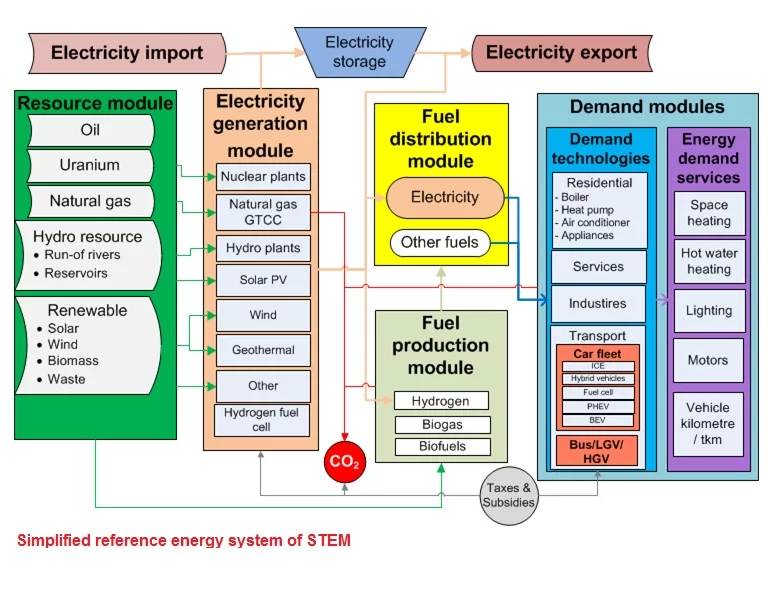Swiss TIMES Energy system Model (STEM) for transition scenario analyses
Understanding how structural changes occur in energy supply requires approaches that are able to represent the structure of the energy system in detail and the main factors affecting structural change. Among these factors, system-wide effects are likely to be particularly important given that technological change in one subsector of the energy system can influence the choice of technology of other sectors, including the energy production and conversion infrastructures. The structural evolution of the energy sector is also driven strongly by energy demands, including temporal and spatial factors; emerging technologies; and linkages mediated by transmission and distribution infrastructure. Although structural change in the energy system is almost certain to occur, the direction and extent of change is affected by uncertain factors related to technology breakthroughs, policy and market developments and external factors such as fossil fuel price and the global carbon market. To account for this range of factors, we developed a technology-rich, bottom-up energy-systems model using the advanced modelling framework TIMES - the Swiss TIMES Energy system Model.

In the Swiss TIMES energy system model (STEM), the full energy system is depicted from resource supply to end-use energy service demands (ESDs), such as space heating, mechanical processes, and personal/freight transport (in vehicle- or tonne-kilometre). The model represents a broad suite of energy and emission commodities, technologies and infrastructure as illustrated in the reference energy system below. The model also combines a long time horizon (2010-2100) with an hourly representation of weekdays and weekends in three seasons. The model is used to identify the least-cost combination of technologies and fuels to meet future ESDs (which are given exogenously based on a set of scenario drivers), while fulfilling other technical, environmental and policy constraints (e.g. CO2 mitigation policy). The model outputs include technology investment and energy commodity use across all sectors, which can be aggregated to report primary energy supply and final energy consumption, seasonal/daily/hourly electricity demand and supply by technology type, carbon dioxide (CO2) emissions, cost of energy supplies, and the marginal cost of energy and emission commodities, among others.
The high level of technology detail ensures that the future energy pathways identified by the model account explicitly for the characteristics of the necessary technology options, and thus are feasible from an engineering perspective. The century long time horizon of STEM facilitates the analysis of long-term goals and challenges, and accounts for the long lifetimes of energy-related capital infrastructure. The high level of time resolution enables STEM to account for the temporal variations in supply and demand, which is critical for evaluating the deployment of intermittent renewables, electrification of transportation and heating, and an emerging need for storage and/or additional flexibility in imports and exports. STEM is thus a powerful tool for the analysis of exploratory transition scenarios of the energy system.
Scenarios on Swiss long term energy supply
Selected set of results are available under Scenarios section
Relevant publications
Kannan R. (2018). Dynamics of long-term electricity demand profile: Insights from the analysis of Swiss energy systems, Energy Strategy Reviews, Vol. 22, pp. p.410-425, DOI:10.1016/j.esr.2018.10.010
Boulouchos K, Cellina F, Ciari F, Cox B, Georges G, Hirschberg S, Hoppe M, Jonietz D, Kannan R, Kovacs N, Küng L, Michl T, Raubal M, Rudel R & Schenler W. (2017). Towards an Energy Efficient and Climate Compatible Future Swiss Transportation System, Vol. SCCER Mobility. ETHZ, PSI, SUPSI & ZHAW, Download
Kannan, R., Hirschberg S. (2016). Interplay between electricity and transport sectors – Integrating the Swiss car fleet and electricity system, Transportation Research Part A: Policy and Practice, Vol. 94, pp. 514-531, DOI:10.1016/j.tra.2016.10.007
Panos, E., Kannan, R. (2016). The role of domestic biomass in electricity, heat and grid balancing markets in Switzerland, Energy, Vol. 112, pp. 1120-1138, DOI:10.1016/j.energy.2016.06.107
Kannan, R. and H. Turton (2016). Long term climate change mitigation goals under the nuclear phase out policy: The Swiss energy system transition, Energy Economics, Vol. 55, pp. 211-222, doi:10.1016/j.eneco.2016.02.003
Kannan, R., H. Turton, E. Panos (2015). Methodological Significance of Temporal Granularity in Energy-Economic Models: Insights from the MARKAL/TIMES Framework, In Giannakidis, G., Labriet, M., Ó Gallachóir, B., Tosato, G (eds.) Informing Energy and Climate Policies Using Energy Systems Models - Insights from Scenario Analysis Increasing the Evidence Base, Vol. 30, pp. 185-200, Springer ISBN 978-3-319-16540-0
R. Kannan and H. Turton (2014). Switzerland energy transition scenarios – Development and application of the Swiss TIMES Energy system Model (STEM), Final Report to Swiss Federal Office of Energy, Bern, External Link, Download
Granacher J. (2018). New energy pathways for the Swiss Industry: A techno-economic analysis of selected industrial energy applications in the light of the Swiss Energy Strategy 2050, Master Thesis, RWTH, Aachen University.
Kannan R., Hirschberg S. (2016). Long term Swiss Mobility Energy Scenarios – An integrated energy systems approach, SCCER-Mobility Annual Conference 2016, Zürich, Switzerland, Poster
Kannan, R., Turton, H. (2014). Transition to a secure and low carbon Swiss energy system, 66th Semi-Annual IEA-ETSAP meeting, Copenhagen, Denmark, Presentation
Kannan, R., Turton, H. (2014). Interplay between electricity and transport sectors -Integrating the Swiss car fleet and electricity system, IAEE European Energy Conference, Rome, Italy, Presentation
Boulouchos K, Cellina F, Ciari F, Cox B, Georges G, Hirschberg S, Hoppe M, Jonietz D, Kannan R, Kovacs N, Küng L, Michl T, Raubal M, Rudel R & Schenler W. (2017). Towards an Energy Efficient and Climate Compatible Future Swiss Transportation System, Vol. SCCER Mobility. ETHZ, PSI, SUPSI & ZHAW, Download
Kannan, R., Hirschberg S. (2016). Interplay between electricity and transport sectors – Integrating the Swiss car fleet and electricity system, Transportation Research Part A: Policy and Practice, Vol. 94, pp. 514-531, DOI:10.1016/j.tra.2016.10.007
Panos, E., Kannan, R. (2016). The role of domestic biomass in electricity, heat and grid balancing markets in Switzerland, Energy, Vol. 112, pp. 1120-1138, DOI:10.1016/j.energy.2016.06.107
Kannan, R. and H. Turton (2016). Long term climate change mitigation goals under the nuclear phase out policy: The Swiss energy system transition, Energy Economics, Vol. 55, pp. 211-222, doi:10.1016/j.eneco.2016.02.003
Kannan, R., H. Turton, E. Panos (2015). Methodological Significance of Temporal Granularity in Energy-Economic Models: Insights from the MARKAL/TIMES Framework, In Giannakidis, G., Labriet, M., Ó Gallachóir, B., Tosato, G (eds.) Informing Energy and Climate Policies Using Energy Systems Models - Insights from Scenario Analysis Increasing the Evidence Base, Vol. 30, pp. 185-200, Springer ISBN 978-3-319-16540-0
R. Kannan and H. Turton (2014). Switzerland energy transition scenarios – Development and application of the Swiss TIMES Energy system Model (STEM), Final Report to Swiss Federal Office of Energy, Bern, External Link, Download
Granacher J. (2018). New energy pathways for the Swiss Industry: A techno-economic analysis of selected industrial energy applications in the light of the Swiss Energy Strategy 2050, Master Thesis, RWTH, Aachen University.
Kannan R., Hirschberg S. (2016). Long term Swiss Mobility Energy Scenarios – An integrated energy systems approach, SCCER-Mobility Annual Conference 2016, Zürich, Switzerland, Poster
Kannan, R., Turton, H. (2014). Transition to a secure and low carbon Swiss energy system, 66th Semi-Annual IEA-ETSAP meeting, Copenhagen, Denmark, Presentation
Kannan, R., Turton, H. (2014). Interplay between electricity and transport sectors -Integrating the Swiss car fleet and electricity system, IAEE European Energy Conference, Rome, Italy, Presentation
